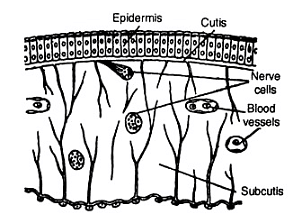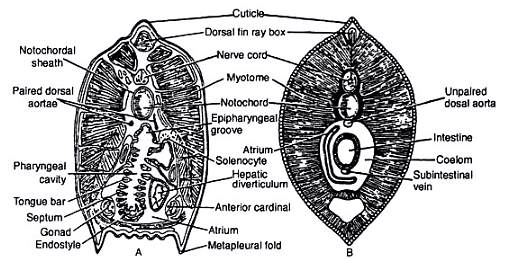UPSC Exam > UPSC Notes > Zoology Optional Notes for UPSC > Protochordata: Origin of Chordates
Protochordata: Origin of Chordates | Zoology Optional Notes for UPSC PDF Download
History and Taxonomy of Branchiostoma
Early Taxonomic Classification
- In 1974, the German zoologist P. S. Pallas attempted to classify these animals, naming it "Limax lanceolatus" and describing it as a slug, but his work was based on ill-preserved specimens and this name was subsequently rejected.
- In 1836, W. Yarrell recognized the uniqueness of these animals and named them "Amphioxus lanceolatus."
- In 1834, O. G. Costa christened them as "Branchiostoma."
- By the rules of taxonomic priority, the name "Branchiostoma" is accepted as the generic name, while "Amphioxus" is used as the common name.
Geographical Distribution of Branchiostoma
- Branchiostoma has a cosmopolitan distribution, found on sandy shores in tidal areas to considerable depths.
- It inhabits tropical and temperate seas.
- The common lancelet, Branchiostoma lanceolatus, has been recorded from the west and southern European coasts, East African coasts, and western and southeastern Indian coasts.
Habit and Habitat of Branchiostoma
- Branchiostoma lives in both marine and estuarine habitats.
- It is commonly found in sandy shores.
- It resides in dilute sea water within the salinity range of 15.4% to 33.1%.
- Branchiostoma can swim actively in water and burrows in the sand but remains near the surface, maintaining a constant water current.
Feeding and Swimming
- Branchiostoma can swim vertically in water without using its fins.
- While swimming, the fins do not play a role in propulsion.
- It feeds on microorganisms brought into its pharyngeal cavity by the respiratory water current, utilizing a ciliary mode of feeding.
External Structure of Branchiostoma
- Branchiostoma is a small, lancelet-shaped creature with pointed anterior and posterior ends.
- Its body measures 5 to 8 cm in length and is elongated and flattened from side to side.
- The anterior end projects forward as a snout or rostrum.
- Below the snout is the oral hood with over twenty stiff buccal or oral cirri.
- The mouth is hidden within the oral hood, and the anus is situated on the left side of the ventral fin.
- The atrium opens through a round atriopore located close to the anterior end of the ventral fin.
- The body has gill slits, usually not visible from outside.
- It features dorsal and ventral fins supported by connective tissues called fin-ray boxes.
- Two longitudinal meta-pleural folds extend along the ventro-lateral sides of the anterior two-thirds of the body.
- These folds help during burrowing in the sand.
Body Wall of Branchiostoma
- The epidermis consists of a single layer of columnar cells.
- Epidermal cells contain sensory hair (receptor cells) but lack gland and pigment cells.
- Beneath the epidermis are the cutis and sub-cutis layers, the latter having a gelatinous matrix containing fibers.
- Canals traverse through both cutis and sub-cutis layers.
- The muscle layer, composed of myotomes, is attached to the gut and undergoes thickening near the notochord to form myotomes.
- About 60 pairs of myotomes run through the entire length of the body, separated by dense connective tissue septa called myocommas.
- The myotomes allow the body to twist sideways during locomotion.

Supporting Structure of Branchiostoma
- The notochord extends from the head to the tail end and is situated above the alimentary canal.
- Other supporting structures include gill rods supporting the gill bars, the skeletal oral ring supporting the oral hood and cirri, and the fin-ray boxes supporting the fins.
- There are two pairs of cardinal veins collecting blood from the ventrolateral sides of the body wall.

Excretory Organs of Branchiostoma
Nephridia
- Branchiostoma has about 90 to 100 paired segmental nephridia, called protonephridia, situated on the dorsolateral wall of the pharynx.
- Each nephridium is a bent vesicular sac with horizontal and vertical limbs, corresponding to each primary gill-bar.
- Elongated tubular flame cells or solenocytes open into the vesicle and have a long tubular stalk with a balloon-like cell body at the terminal end.
- The solenocytes are associated with nephric glomerular sinus.
- Excretion occurs through the solenocytes via diffusion, with waste products passing into the vesicle through the tubular part.
Nephridium of Hatschek
- A tube called the nephridium of Hatschek is also considered to have an excretory function, extending from the mouth to the right side of the notochord.
Brown Funnels and Atrial Wall
- A pair of brown funnels in the atrium is thought to play an excretory role, although they may serve as receptor organs.
- Groups of cells in the atrial wall are involved in excretion.
Gonads
- The gonads, particularly in the testes, contain yellow masses with uric acid, expelled with the gametes.
Nervous System of Branchiostoma
- Branchiostoma has a hollow dorsal nerve cord located just above the notochord.
- The anterior part forms the brain, while the posterior part remains as the spinal cord.
- Paired nerves emerge from the dorsal and ventral nerve roots in each segment of the body.
- The nervous system includes a ventricle at the anterior end and the infundibular organ, which contains tall cells with cilia and produces Reissner's fiber.
- Photo-sensory cells are present on the spinal cord.
- The spinal cord is characterized by a narrow central lumen and the orientation of grey matter and white matter is similar to that of vertebrates.
- There are sensory cells on the surface of the body, especially on the dorsal side.
Receptor Organs in Branchiostoma
- Branchiostoma features various receptor organs, including pigment spots on the anterior wall of the brain, eye-spots on the spinal cord, Kolliker's pit, sensory papillae on the oral cirri and velar tentacles, infundibular organs, and epidermal sensory cells on the body's surface.
Reproductive System of Branchiostoma
- Branchiostoma exhibits separate sexes with simple pouch-like gonads located in the ventro-lateral sides of the pharyngeal region between the 10th and 30th segments.
- Gametes are discharged into the atrium and released into the water through the atriopore for fertilization and development.
Development of Branchiostoma
Primitive, Degenerated, and Specialized Features
- Branchiostoma displays a combination of primitive, degenerative, and specialized features.
- Primitive characteristics include a persistent notochord, single-layered epidermis, myotomic segmentation, and ciliary mode of feeding.
- Degenerative features include a sedentary lifestyle, reduced brain and sense organs, and retrograde development in adults.
- Specialized features include a spacious pharynx, a large number of gill-slits, and specialized feeding structures.
Affinities and Systematic Position of Branchiostoma
- Branchiostoma is classified within the phylum Chordata due to its possession of key chordate features, including the notochord, dorsal tubular nerve cord, and gill-slits.
- Its precise position within the phylum is still uncertain, and it has been proposed to be related to various groups, including annelids, mollusks, echinoderms, vertebrates, hemichordates, and urochordates.
- Its close relationship with urochordates and similarities in larval development suggest a connection between Branchiostoma and urochordates.
- While comparisons have been made with various animal groups, the exact systematic position of Branchiostoma remains a subject of debate in evolutionary biology.
The document Protochordata: Origin of Chordates | Zoology Optional Notes for UPSC is a part of the UPSC Course Zoology Optional Notes for UPSC.
All you need of UPSC at this link: UPSC
|
198 videos|351 docs
|
FAQs on Protochordata: Origin of Chordates - Zoology Optional Notes for UPSC
| 1. What is the history and taxonomy of Branchiostoma? |  |
Ans. Branchiostoma, also known as lancelets or amphioxus, is a genus of small marine invertebrates belonging to the subphylum Cephalochordata. They are the closest living relatives of vertebrates and are considered to be one of the earliest chordates. The taxonomy of Branchiostoma includes several species, such as Branchiostoma lanceolatum and Branchiostoma floridae, which have been extensively studied for their evolutionary significance.
| 2. What is the habitat and habit of Branchiostoma? |  |
Ans. Branchiostoma is primarily found in marine habitats, particularly in sandy or muddy coastal areas. They are typically burrowed in the sediment with only their anterior end exposed. Branchiostoma is a filter feeder, meaning it feeds on small particles suspended in the water. They use their oral cirri to create a feeding current and capture food particles, such as plankton and detritus.
| 3. What are the external structures of Branchiostoma? |  |
Ans. The external structure of Branchiostoma consists of a streamlined body shape, which is elongated and cylindrical. They have a translucent body with a notochord running along the entire length of their body, providing support. Branchiostoma also has numerous myomeres, which are segmented muscle blocks responsible for locomotion. Other external structures include a well-developed oral hood, tentacles, and gill slits for respiration.
| 4. How does Branchiostoma reproduce? |  |
Ans. Branchiostoma is hermaphroditic, meaning individuals have both male and female reproductive organs. They reproduce sexually by releasing eggs and sperm into the water, where external fertilization takes place. After fertilization, the embryos develop into free-swimming larvae called "leptochephalus," which undergo metamorphosis to become adult amphioxus. The reproductive system of Branchiostoma is relatively simple compared to vertebrates but still exhibits complex developmental processes.
| 5. What is the significance of Branchiostoma in understanding the origin of chordates? |  |
Ans. Branchiostoma is of immense significance in understanding the origin and evolution of chordates, including vertebrates. As one of the closest living relatives of vertebrates, studying Branchiostoma provides valuable insights into the ancestral characteristics and evolutionary transitions that led to the development of vertebrates. By examining the anatomy, development, and genetic makeup of Branchiostoma, scientists can unravel the key evolutionary steps that shaped the chordate lineage.
Related Searches
















